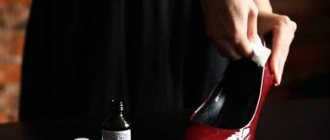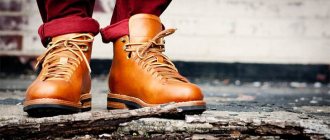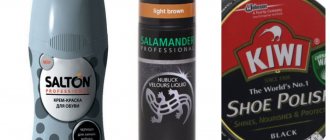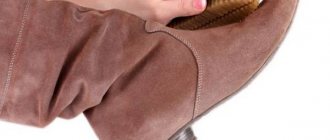Proper winter shoes should not only be warm and comfortable, but also stable. As a rule, treads—carved “patterns” on the sole of shoes—are responsible for grip on the surface. Treads depend not only on the material from which the sole is made, but also on the purpose of the shoe - for example, the tread on hiking shoes should provide very good traction, regardless of the weather, while the tread on everyday summer shoes will look much simpler. That is why for winter it is worth choosing shoes that have a textured sole surface and avoid smooth ones.
However, if you have already purchased shoes and they slip mercilessly, there are several ways to protect yourself.
How to store shoes: 15 original and practical life hacks
Coca Cola
No matter how strange the use of Coca-Cola may seem at first, this drink is the most common among athletes and an effective solution to get rid of the problem:
- Before training, the soles are doused with Coca-Cola.
- The sneakers must dry.
It is permissible to confidently head to the gym; slipping in the products will be kept to a minimum. The effectiveness of the work done will be short-term; the actions will need to be repeated regularly before training.
Outsole material
Winter shoe models are not made from all materials. If they are not resistant to frost, the base outside will harden and slip even more. As a rule, the following materials are used in the manufacture of soles:
- Thermoplastic elastomer. Its main advantage of TPE is considered to be frost resistance. It can withstand temperatures down to minus 45 degrees. The best non-slip soles for autumn and winter are made from TEP.
- Polyurethane. Suitable for making demi-season shoes; considered unsuitable for winter shoes. In cold weather it slides a lot, at minus 20 degrees it simply bursts.
- Thermopolyurethane. Does not slip, but is not able to fully retain heat. As a rule, this material is used with polyurethane.
- Polyvinyl chloride. It makes winter shoes very slippery. Also, the material does not withstand frost and bursts even under slight load. It is used only for the manufacture of demi-season shoes.
- Ethylene vinyl acetate. It has minimal weight and is often used in the manufacture of clogs and demi-season boots. The material is able to retain heat and does not allow moisture to pass through. True, sliding soles are not used for shoes intended for the winter period.
- Rubber. Time-tested material, characterized by flexibility, elasticity, wear resistance. The rubber base is resistant to low temperatures, non-slip, although heavy. Feet in such shoes get tired quickly.
The best base for winter shoe models is rubber and thermoplastic elastomer. These are fairly soft, elastic materials that are in demand among manufacturing companies. Most often, TPE is preferred due to its lightness.
Shoes with thermoplastic elastomer soles should be dried very carefully. It is prohibited to place it near heating devices, as the material may melt and lose its original properties.
TEP
Rubber
Polyurethane
PVC
TPU
EVA
How to properly walk in icy conditions outside?
Photo by Pixabay
As soon as ice appears on the roads, we begin to move through the streets, as if with crystal vases in our hands (from the sideboard with family treasures). And it is right! You shouldn’t count the remaining bullfinches and study yourself in shop windows – watch your step (the ice doesn’t forgive bullies).
Therefore, we remember the rules for competent movement in icy conditions:
- We change our gait. We don’t run after the bus, we don’t rush, we walk slowly, in small steps, stepping on the entire sole.
- We don't keep our hands in our pockets. In the event of a sudden fall, this recklessness can cost not only a fracture, but also a traumatic brain injury. Busy hands? Distribute the weight evenly on your hands.
- Don't forget about the right shoes.
- We calculate dangerous sections of the path and change the route in advance (or go as carefully as possible).
- We move along roads with caution - we reduce the risk of flying right under a car.
- Learning to fall correctly. We do not fall on our hands to avoid fractures and sprains. If we lose balance, we try to group ourselves, bend our knees (in the direction of the fall) and press our hands to our body, and when we touch the ground, we roll to “dissipate” the force of the impact. We avoid falling on our back with any acrobatic tricks.
- Keep your body slightly tilted forward .
- We don’t kick back if we hit someone with our shoulders while being late for our business.
- We do not ignore a visit to the doctor if a fall does occur and the blow was severe.
If you are not particularly careful, recommendations fly out of your memory immediately after reading, and you will never take off your stiletto heels, then carry a pair of cotton tights or stockings - you will need them in the emergency room. A stocking stretched under a cast will protect you from itching, skin irritation and the feeling of tightness in your hair.
Anti-slip devices for children's boots
Little children are real fidgets. They lead an active lifestyle, so it is necessary to select reliable methods to protect them on winter days. It is important that their shoes remain as functional and comfortable. The main rule is that we should not save on the health of our children.
To protect children, consider one of the following methods:
- Buy boots with grooved or patterned soles right away so that there is no need for additional protective equipment. In such shoes the child will be most comfortable during children's games and fun on the street;
- professional options such as anti-slip rubber pads, children's ice pads or elastic bands . They look beautiful, are firmly attached and do not fall off on their own during a walk;
- Of the methods that you can recreate at home yourself, you can use felt, flannel or sandpaper linings for children's shoes. They create the strongest grip on the ground and are more durable. It is unlikely that a well-adhesive pad will come off in the middle of a walk.
All other methods described in the article should not be used for children. They are not reliable enough and are not suitable for actively moving children.
Knitted pleated skirt
Guipure dresses 2022: new models
What kind of shoes don't slip?
Flat boots with elastic soles will be a real salvation in icy conditions. The best outsole material is rubber or rubber. The second option is easy to recognize among other materials: it is distinguished by its light color and high grain size. A rubber sole can be identified by its characteristic roughness; it can be easily pressed with a finger.
Contrary to popular belief, deep tread is not always a reliable anti-slip solution. This sole is good in heavy snowfalls, but for good grip on ice, you should choose an option with many small pimples or multi-directional notches. Some expensive shoe models provide special protection in the form of metal spikes or special inserts.
Primary requirements
The two main factors that determine the degree of slip are the material of the sole and the depth of the tread on it . The country of origin is important - it is advisable to choose one that experiences cold weather. Non-slip shoes provide good traction on the road, even when the road is icy or covered with snow. In winter, this possibility exists if there are soft tires.
Popular materials for making soles of winter and demi-season shoes and their properties:
- Thermoplastic elastomer. One of the most stable types, combining the qualities of thermoplastics and vulcanized rubber. It has strength, flexibility, frost resistance, and wear resistance. It retains its properties at temperatures down to -45 °C. Advantages: lightness, long service life, low cost.
- Thermopolyurethane. This is a polymer material. The sole made from it looks modern and has a number of advantages: wear resistance due to its high density, resistance to bending and abrasion, frost resistance at temperatures down to -50 ° C. It has good grip on the road surface, which virtually eliminates slipping. A disadvantage is the low degree of bendability.
An important rule for choosing non-slip shoes is to carefully study the tread. The main requirement for it is sufficient relief depth. A pattern with different directions is welcome, since only transverse or diagonal stripes will not provide complete slip protection. It is good if the teeth of the sole are arranged crosswise. A combination is possible when one part is made in the form of round protrusions, and the second consists of strips.
The size of the teeth depends on who the boots are intended for. A more elegant and discreet option is suitable for women, while powerful protectors with large elements are suitable for men.
Thermoplastic elastomer
Thermopolyurethane
Deep outsole tread
Drawing with different directions
The teeth of the sole are arranged crosswise
Method 6
Take it to the specialist and together with him choose the appropriate method for correcting the sole. Depending on the shoes themselves, a specialist may suggest screwing in metal screws or installing iron heels (the downside is that a loud clicking sound may appear when walking), installing overlays, and also deepening the tread if the thickness of the sole allows. The quality of the result will depend entirely on the experience of the master.
There are many ways to prevent shoes from slipping, but we still recommend paying attention to the sole when choosing a new pair of shoes - this way you will save time and, perhaps, protect yourself or your loved ones from falling.
Is it possible to wash sneakers in a washing machine, and if so, how to do it?
Photo: instructables, Wapiti Travel, pinterest
Ineffective methods
When looking for effective solutions to prevent shoes from slipping at home, you may come across a lot of useless advice. Such life hacks are quite advertised. But who tested them and what results they got is unknown. The most useless ways:
- Using a kitchen grater. The essence of the method: rub the slippery sole with a coarse grater. This manipulation will bring nothing but its damage. And even more so, it is not suitable for shoes with a very thin base.
- Hair fixation spray. The spray applied to the sole is believed to have water-repellent and anti-slip properties. In fact, this is nothing more than fiction, which means you shouldn’t waste time on this method.
- Potato. As with varnish, it is believed that starch has anti-slip properties. Some claim that protection will be provided by rubbing half a potato on the sole. However, there will be no result other than starchy stains.
If your shoes slip, you should not resort to untested methods. It would be much more correct to study the issue in more detail and choose the best solution to the problem.
A grater will only ruin the sole
Hairspray has no effect
Potatoes do not have anti-slip properties
Homemade protector
When sneakers have a flat, smooth sole, small screws help add relief to it and eliminate slipping. They are screwed into several places. To prevent the pointed end from causing damage to the shoe before the procedure, it is necessary to bite off the pointed part using pliers.
This technique is available only in a situation where the product has a dense, wide sole; thin screws can deform.











